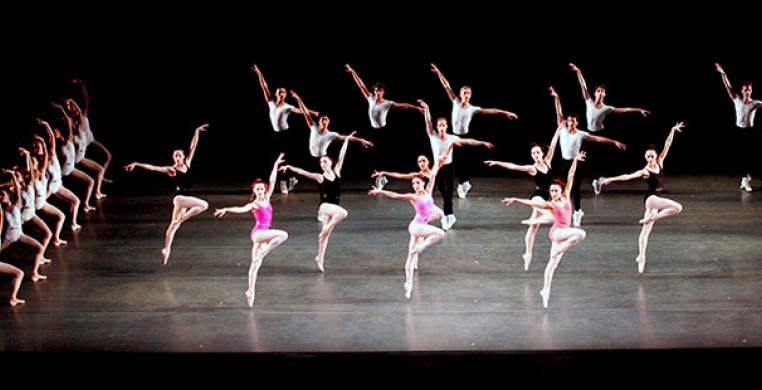Miami City Ballet cruised into town this past Friday with a luscious program that soared on a wave of musical complexity and choreographic brilliance. In each of the three large-scale ballets in the first of its two-program weekend, killer choreography showed off the company’s technical chops, while superb movement design made grand partnerships with great symphonic music, performed live by the Chicago Philharmonic. If Friday’s program was any indication, music is important to the Miami City Ballet. What a treat!
Chicago’s Harris Theater stage was the perfect venue for George Balanchine’s expansive “Symphony in Three Movements” (1972), set to Igor Stravinsky’s 1945 score of the same title. In a prime example of the choreographer’s innovative use of contrapuntal group patterns as visual orchestration of the music, MCB’s thirty-two dancers filled the stage with an exhilarating blend of musicality and dance of the highest order. Contrasting battalions of all-white and black-and-white-clad corps de ballet dancers tossed off fiendishly difficult sequences of leaps and struts, geometrics ruling the day. Plenty of parallel legs, flexed feet and forced-arch point work painted a jazzy canvas, reflecting the jazz-inspired score with turned-out leaps twisting mid-air into bent knees pressed together. Broad, scissor-sharp sissones alternated with a recurring prancing motif and the vibrance of thoroughbreds changing direction at break-neck speed. Falls to the floor and low-slung lunges with hovering, wing-like arms, and knees in lightning-fast turn-in/turn-out gestures raced with the music.
Balanchine’s characteristically simple bare stage and dancers in streamlined practice clothes accentuated spatial design as the star of the show. That’s not to say that the three stellar ballerinas--Natalia Arja, Ashley Knox, and Tricia Albertson in variations of pink leotards--didn’t have their day in the sun. The three lead couples set off on a steeple chase of lifts and leaps, the rousing tympani building momentum to a climactic first movement resolution. The poignant second movement duet, somewhat reminiscent of Balanchine’s “Bugaku,” could have been the mating dance of two butterflies, delicately lyrical in its twirling hands, intertwining arms, and exquisite lifts, sustained on attenuated strains of harp, flute, and oboe. The stunning final movement built to a pinnacle of excitement and brought cheers at its full-force ending. How rare and how special it is for Chicago to see such a masterful rendering of work so rich in choreographic substance--movement invention that startles the senses, and a breathtaking fugue of music and spatial design.
Liam Scarlett’s “Viscera” (2012), set to Lowell Liebermann’s dramatic Piano Concerto No. 1, has an intensity of its own, with the incessant urgency of the piano driving the first section. While “Symphony in Three Movements” and “Viscera” are both abstract ballets, the latter exudes strong emotion, in contrast to Balanchine’s empirical detachment. Scarlett’s movement palette is angular and modern, full of sharp attack, corresponding to the driven sounds of brass and tympani; the stage stark, with women in backless purple velvet leotards and men in mauve bare-legged form-fitting unitard shorts. Constant, urgent group movement characterizes the first section. Beginning with an isolated woman on stage in silence, there is the hint of a central character. The slow second section duet, and absolutely gorgeous pas de deux, is a nuanced conversation, suggesting a narrative arc in the couple’s relationship--she vulnerable, rapping around him, he lifting her into an overhead split that curves into a back arch in attitude. She backs away, leaving him alone on stage. Part three explodes in frantic urgency with precision ensemble work to rushing piano and strings. Multiple kicks command a trombone blasts from the orchestra as the whole company congeals in unison form, then explodes into chaos and a fantastically sudden finish.
Alexei Ratmansky created his “Symphonic Dances” (2012) for Miami City Ballet, set to Sergei Rachmaninoff’s 1941 composition of the same title. This piece stands in stark contrast to the two preceding pieces in its reliance on flow, breath, and weight with a more conventional ballet vocabulary. In addition, despite Ratmansky’s program disclaimer, there is a loose narrative thread defining relationships and social boundaries, carried out in the costuming as well as the dramatic structure of a protagonist--a compellingly sympathetic Kleber Rebello in white with a red star on his back--and his mentor, the intense Renato Penteado. Rebello’s pursuit of a love interest, and the group’s thwarting of his efforts adds context to his actions. Costuming in the first section has the women in long, gauzy shifts that drape and sway with their movement, the men in loose peasant tunics and pants, suggesting a peasant community. Movement is curved and lyrical, with sustained arcs of arms and swooping bodies, suspensions and a sense of flight in airy leaps. Ratmansky makes good use of off-balance partnering, the weight of one dancer falling into another. Part two is a dream-like romantic ballroom scene, a lavish waltz, that has the men in exaggerated tuxes with giant boutonnieres, the women in jewel-tone organdy gowns. Part three challenges our need to assign a story to the dancing, with a drastic change of costume--the men wear short-sleeve hoodies with a large black splotch on the back, and the love interest in white, now with a matching red star on her dress. Is this blood? Pain? A mark of exclusion? We don’t know and we don’t necessarily care, because the dancing is wonderfully exciting. Athletic running builds to the ballerina’s emergence upstage in a sequence of brilliant fouetté turns and a spinning leap into her lover’s arms for a heart-stopping finish.

